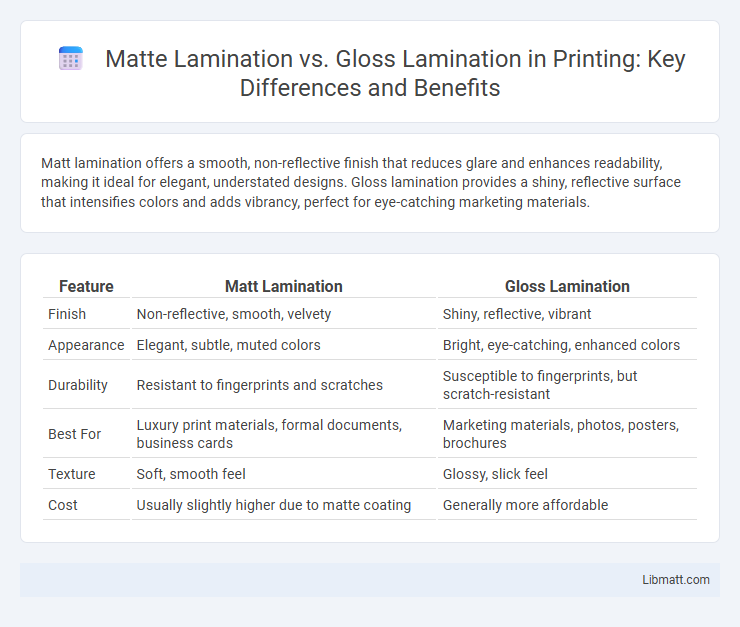Matt lamination offers a smooth, non-reflective finish that reduces glare and enhances readability, making it ideal for elegant, understated designs. Gloss lamination provides a shiny, reflective surface that intensifies colors and adds vibrancy, perfect for eye-catching marketing materials.
Table of Comparison
| Feature | Matt Lamination | Gloss Lamination |
|---|---|---|
| Finish | Non-reflective, smooth, velvety | Shiny, reflective, vibrant |
| Appearance | Elegant, subtle, muted colors | Bright, eye-catching, enhanced colors |
| Durability | Resistant to fingerprints and scratches | Susceptible to fingerprints, but scratch-resistant |
| Best For | Luxury print materials, formal documents, business cards | Marketing materials, photos, posters, brochures |
| Texture | Soft, smooth feel | Glossy, slick feel |
| Cost | Usually slightly higher due to matte coating | Generally more affordable |
Introduction to Matt and Gloss Lamination
Matt lamination provides a smooth, non-reflective finish that reduces glare and enhances readability, making it ideal for premium packaging and sophisticated print materials. Gloss lamination, on the other hand, offers a shiny, reflective surface that intensifies colors and adds vibrancy, often used in marketing collateral and promotional items. Both lamination techniques protect printed materials from wear and tear while elevating their visual appeal.
What is Matt Lamination?
Matt lamination is a finishing process that applies a smooth, non-reflective film over printed materials, enhancing durability while providing a subtle, elegant look. This lamination reduces glare and fingerprints, making your packaging or promotional materials more visually appealing and easier to read. Unlike gloss lamination, matt lamination delivers a soft, muted finish that adds a sophisticated touch to your product's presentation.
What is Gloss Lamination?
Gloss lamination is a printing finishing technique that applies a shiny, reflective plastic film over printed materials, enhancing color vibrancy and providing a smooth, eye-catching surface. This lamination protects against moisture, scratches, and wear while making images and text appear more vivid and polished. Suitable for marketing materials like brochures and postcards, gloss lamination increases visual appeal and durability.
Key Differences Between Matt and Gloss Lamination
Matt lamination provides a smooth, non-reflective finish that reduces glare and enhances readability, while gloss lamination creates a shiny, reflective surface that intensifies colors and visual appeal. Matt lamination tends to resist fingerprints and scratches better, making it ideal for products requiring a subtle, elegant look, whereas gloss lamination is preferred for vibrant, eye-catching prints, such as magazine covers and promotional materials. The choice between matt and gloss lamination significantly impacts the tactile experience and durability of printed materials.
Benefits of Matt Lamination
Matt lamination offers a non-reflective, smooth finish that enhances the readability and aesthetic appeal of printed materials by reducing glare and fingerprints. It provides excellent durability and resistance to scratches and moisture, extending the lifespan of packaging, brochures, and business cards. Additionally, matt lamination imparts a sophisticated, premium look that appeals to luxury brands and high-end products.
Advantages of Gloss Lamination
Gloss lamination enhances printed materials by providing a shiny, reflective surface that intensifies colors and makes images appear more vibrant. It offers excellent resistance to moisture, dirt, and fingerprints, extending the durability of promotional and packaging products. This type of lamination is often preferred for marketing materials aiming to attract attention with a high-impact, professional finish.
Best Uses for Matt Lamination
Matt lamination is ideal for premium packaging, business cards, and luxury product catalogs due to its elegant, non-reflective finish that enhances readability and conveys sophistication. It reduces glare and fingerprints, making it perfect for marketing materials viewed under various lighting conditions. This lamination type also offers excellent scratch resistance and durability, preserving the quality and appearance of high-end printed items.
Ideal Applications for Gloss Lamination
Gloss lamination is ideal for packaging, brochures, and promotional materials where vibrant color enhancement and high visual impact are essential. Its reflective surface makes images and graphics appear sharper, attracting consumer attention in retail displays and product covers. This lamination type is particularly effective for marketing collateral requiring durability combined with a sleek, shiny finish.
Choosing the Right Lamination for Your Project
Matt lamination provides a smooth, non-reflective finish that enhances readability and offers a sophisticated, subtle look suitable for elegant or minimalist designs. Gloss lamination delivers a shiny, vibrant appearance that intensifies colors and adds durability, making it ideal for eye-catching promotional materials and packaging. Choosing the right lamination depends on your project's aesthetic goals and functional needs, balancing visual impact with texture and protection.
Conclusion: Which Lamination is Best for You?
Matt lamination offers a sophisticated, glare-free finish ideal for a subtle and elegant look, while gloss lamination provides a shiny, vibrant surface that enhances color intensity and protects against moisture. The best lamination choice depends on your project's purpose: choose matt for a premium, muted aesthetic suitable for luxury packaging and business cards, or gloss for eye-catching marketing materials and photo prints requiring a high-impact visual appeal. Consider durability, visual preferences, and where the material will be used to determine which lamination best aligns with your branding and functional needs.
Matt lamination vs gloss lamination Infographic

 libmatt.com
libmatt.com